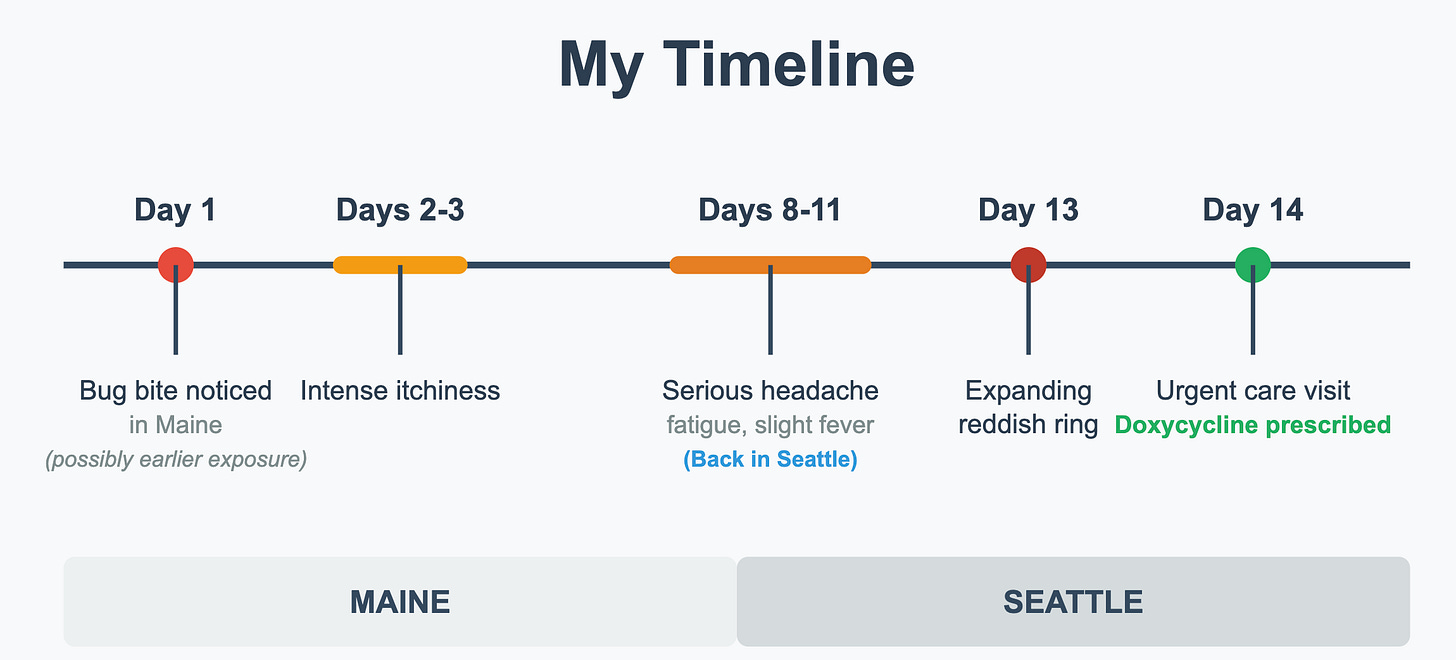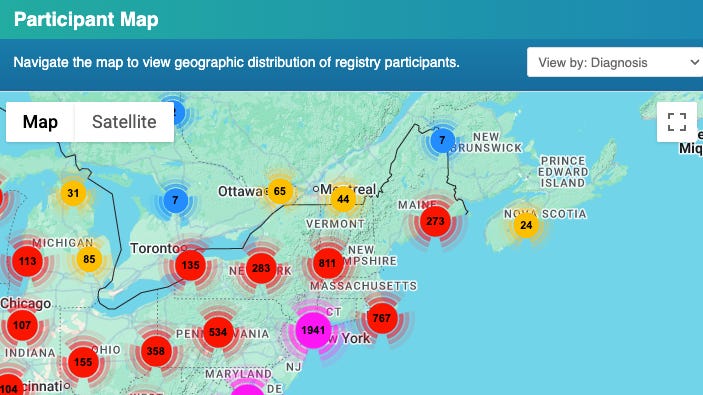Personal Science Week - 250904 Lyme
Explaining a sudden headache and rash
A few weeks ago while vacationing in Maine, my son and I went on a short hike in one of the beautiful forested trails near where we were staying. Knowing that ticks are a potential hazard in the northeast, we inspected ourselves carefully afterwards to ensure that no hidden travelers had crawled on us.
Despite that careful attention, I apparently caught a Lyme disease infection. This week I’ll describe the details of my situation and my response.
After the Hike
Later that evening I noticed what seemed like a very itchy bite on my inner thigh. Like any good personal scientist, I stay vigilant about my body and health, so I took a photo and consulted ChatGPT.
"Unlikely to be a tick," it assured me. Tick bites don't typically itch right away, and there was no sign of the classic bullseye pattern. Much more likely to be simple “folliculitis” (sweat stuck inside a hair follicle can get inflamed), or maybe a spider or deer fly. Made sense. The location—protected under clothing—seemed odd for a hiking encounter anyway. And everything was fine for the rest of my trip.
Eight days later, back home in Seattle, the headache started.
The last time I had a headache and fever was back in the Spring (PSWeek250424), when I had a clear case of the influenza that was spreading at the time. But now there doesn’t seem to be any flu in my community (OutbreaksNearMe), and this headache is a doozy — among the worst I’ve ever had. I was unable to work for three days.
But literally the day after the headache lifted, that original bite location suddenly expanded into a large rash. What I'd dismissed as a random bug bite now showed the classic expanding rash (erythema migrans) that appears in 70-80% of Lyme cases.
Taking It Seriously
Lyme is a nasty condition precisely because it seems to flare up and then disappear. Most people probably don’t connect the headache and the bug bite at all, and they assume that the immune system was victorious anyway. No symptoms, no disease.
But having talked to hundreds of Lyme sufferers over the years, I knew things are not nearly that simple. The Lyme bacteria (Borrelia burgdorferi) is most nasty precisely when the symptoms go away, because that’s when the bacteria find a way to dig into new parts of the body where they can hide from the immune system, often for months or years before they expand again and generate new symptoms.
Maine has high tick density with Lyme bacteria endemic in coastal forest zones. Without treatment, the statistics for somebody like me are scary:
15-20% develop neurologic complications
4-8% develop cardiac manifestations
60% develop Lyme arthritis within 2 years
5-15% suffer chronic neurologic sequelae
Fortunately the treatment is easy and effective, and I immediately started a 2-week course of the antibiotic doxycycline, available everywhere for about $20. I normally avoid antibiotics—they mess with the microbiome with unknown consequences—but in my case I think doxycycline is an easy exception. It’s different from other antibiotics (which I haven’t taken in years), because it crosses the blood-brain barrier and can get to tissues where the Lyme bacteria try to hide.
A Disease Out of Nowhere?
Having written about Lyme before and knowing several chronic sufferers, I've always been intrigued by its peculiar history. Lyme disease seemingly appeared out of nowhere in the 1960s-70s, first identified in a cluster of juvenile arthritis cases near Lyme, Connecticut in 1975.
Some people think Lyme disease was invented by former Nazi scientists who were experimenting with dropping ticks from planes. One of their experiments supposedly escaped in the 1970s from a top-secret army research base in Long Island which has subsequently been shown to have had documented safety breaches. While the official narrative attributes Lyme's emergence to suburban expansion into deer habitat, the geographic and temporal coincidence raises questions. (Read more details in Unpopular Science 230919)

What we do know: Borrelia burgdorferi DNA has been found in museum specimens and even Ötzi the Iceman (5,300 years old), so the bacterium isn't new. But something changed in its prevalence or virulence mid-20th century.
Adding insult to injury, we actually had a Lyme vaccine (LYMErix) in the late 1990s that was 76% effective. Despite no safety issues, it was pulled in 2002—not for medical reasons but due to poor sales and litigation fears. Imagine if we still had that option today.
As mentioned in PSWeek240321, MIT researchers identified a unique protein in human sweat that appears to ward off the microbe responsible for Lyme disease. The secretoglobin is produced by a gene called SCGB1D2 (rs2232950). My 23andMe shows I'm C/C—theoretically protected.
Yet here I am starting doxycycline for probable Lyme. Importantly, I didn’t bother with a $100 Lyme serology test (available in-person only from Quest and others). Though normally I’m all in favor of any kind of testing, this one is notorious for its false negatives: you get a reassurance that you’re fine, only to learn years from now that you’re not. And what’s the point of the test when the treatment is so easy, cheap and safe? Interestingly, some of the more reputable at-home testing companies like LetsGetChecked and Everlywell don’t sell it anymore, presumably because of that false-negative problem.
Meanwhile, I also registered myself with MyLymeData, a project of the Lyme Disease.org non-profit 501(c)(3). They ask all Lyme sufferers to record their health data, and their site lets you compare yourself to others in their registry.
Unfortunately I didn’t have good luck when I tried to enter my own data and there doesn’t seem to be a way to update incorrectly entered data entered. I’ve reached out to their support people and hope to hear back in time to be of use to their dataset.
Finally
The bottom line is I’m glad I paid close attention to my body. I already take brief, daily notes about sleep, food, etc. that made it much easier to pinpoint the start of the infection. That initial bug bite photo proved very useful later when the rash started to expand. Personal science pays!
Speaking of tracking my health, I also now just ordered the new SiPhox “Longevity+” test that includes 100+ biomarkers for only $190. These are the same biomarkers you get from Function Health for $400, so that’s quite a deal already. Pro Tip: Get the test for $142 if you log in to Siphox Health and use the code RICHAR143584, making this one of the best blood testing deals I’ve heard of ever. Note: this is not an at-home test: they give you paperwork that you take to your local LabCorp for a full blood draw—just like Function Health (PSWeek240912)
About Personal Science
Personal scientists use the tools of science for personal, rather than professional reasons. We approach our health with curiosity, skepticism, and systematic observation—documenting symptoms, tracking patterns, and making evidence-based decisions even when the evidence is incomplete.
We publish every Thursday for anyone who wants to think more scientifically about their own health and life. Past topics include sleep tracking with AI, microbiome testing, blood biomarkers, and much more.
If you have comments, questions, or suggestions for future posts, let us know.





